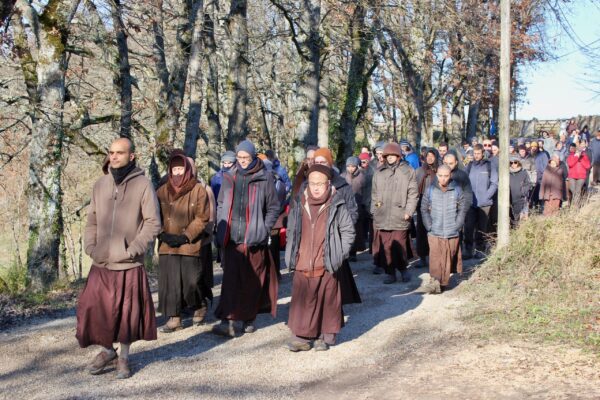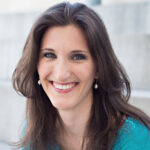This article was originally published in Religion News Service, with the support of CRCC’s global project on engaged spirituality.
The past school year was the most challenging in Jon Salunga’s teaching career. It was more than navigating new technologies and hybrid in-person/online schedules. The San Diego high school English teacher helped students who were at home caring for younger siblings or grandparents while their parents worked. He watched his students’ mental health suffer. Salunga had his own grief too, having lost a family member to COVID-19.
Between virtual classes, Salunga would turn away from the screen, breathing to decompress his eyes, mind and body, a mindfulness technique he first learned in a retreat he had attended while getting his teacher’s certification 20 years ago.
Besides giving him relief from stress, mindfulness practice helped him maintain compassion for his students — and himself. “Understanding my own capacity and being able to accept that,” Salunga said, “is one of the areas that I have been practicing with.”
This summer, as teachers prepare to reenter classrooms after a year of pandemic teaching, many are seeking out mindfulness to support their own mental and emotional wellness.
Mindfulness can be found in schools in every U.S. state and around the world, according to Amy Saltzman, director of the Association for Mindfulness in Education. The association’s 3,000 members include individual teachers with a personal practice, as well as those who share mindfulness in the classroom, entire schools and even districts.
Organization such as Goldie Hawn’s MindUP for Life and Mindful Schools offer curriculum and training, while for-profit meditation apps Calm and Headspace also have resources for educators.
Saltzman said the pandemic has brought attention to teachers’ need for greater support, at the same time that it has limited their ability to seek it out. “Teachers are super stressed right now as they start to go back.”
Salunga learned how to apply mindfulness to his professional life from Thich Nhat Hanh, the Vietnamese Buddhist monk, teacher and bestselling writer who did much to popularize mindfulness by adapting Buddhist traditions to Western culture.
Thich Nhat Hanh’s Wake Up Schools movement has taught hundreds of teachers in Vietnam, India, Europe and the United States through online retreats, courses, workshops and monthly gatherings during the pandemic. In August, it is co-sponsoring a virtual retreat for U.S. teachers with the Barre Center for Buddhist Studies in Massachusetts.
Orlaith O’Sullivan, Wake Up School’s international coordinator, sees a critical need for the organization’s training as schools emerge from pandemic lockdowns. “This is the quietest and slowest that our world will ever be,” she said. “Daily life is only becoming louder and faster, and we need an intentional active resistance for our safety and well-being so we can live our lives well.”
The movement is about spreading happiness, not necessarily Buddhism, said O’Sullivan. In education, secular mindfulness — teaching people to pay attention to the present moment without reference to a Buddhist worldview — is often promoted as a tool to help students improve their academic and behavioral skills. But teachers may be in equal need, said Richard Brady, a retired math teacher and author of “Walking the Teacher’s Path With Mindfulness: Stories for Reflection and Action.”
“Even a little amount of mindfulness can go a long way to help teachers relax when they feel stressed,” he said.
At the same time, Brady, a lay dharma teacher in Thich Nhat Hanh’s Plum Village tradition, said the monk wanted to make sure that his teachings were not sold as “a tool to fix things.”
“The big difference between Wake Up Schools and every other organization that I know much about is that Wake Up Schools is … about living your life with mindfulness,” said Brady.
Brian Beard, an English teacher at a private school in Houston, started attending a local Plum Village sangha, or community, in addition to his Christian church. During the 2020 winter break before the pandemic reached the U.S., he attended a Wake Up Schools retreat, where he said he learned “what is transmitted is who we are, more than the actual knowledge.”
This spring, Beard and a colleague started meditating together once a week after school, and other colleagues have expressed interest in joining them. He also told his students about his experiences with Plum Village and a Christian contemplative retreat.
In some classes, students voted to try activities such as mindful movement, eating meditation and deep relaxation. They also reflect on their experience. At Plum Village, retreatants put their hands together and bow before sharing in a group setting. To make the gesture secular, Beard has students snap instead of bow.
Students said during the reflections that even a few minutes of quiet makes them feel calmer. Beard also noticed it helps them be stronger, clearer, more focused readers and writers, even if he sees the benefits going beyond academic skills.
“Helping students get in contact with the parts of themselves which are good and loving and empathetic, that’s what keeps me excited about teaching,” Beard said.
But mindfulness still faces criticism from two sides. Due to its religious roots, some see it having no place in secular settings such as public schools. Yet mindfulness also risks being commercialized, focused solely on improving students’ performance.
Saltzman sees mindfulness training as teaching “innate human qualities” — including kindness and compassion — that do not require a particular belief system or worldview.
“These are just practical, useful life skills,” Saltzman said. “You don’t need to be Buddhist or anything else to practice them, any more than you need to be Italian to eat pizza.”
Still, teachers in U.S. public schools have to ensure that the practices they bring into the classroom are secular, she said.
Salunga, a Catholic Filipino American, appreciates that he does not have to give up his faith to practice mindfulness in the Plum Village tradition. At the same time, when it comes to his public-school classroom, “my approach has been to not name it as mindfulness,” he said.
For instance, mindfulness practitioners often use a bell as a reminder to pay attention to their breath and return to the present moment. In Salunga’s classroom, a bell — without explicit instructions about breathing — serves as a nonverbal cue to start class or regroup between activities.
Mindfulness is about the values Salunga brings into the classroom, particularly teaching in an economically and culturally diverse community.
“What does generosity look like for my students?” Salunga said. “Especially during the pandemic, this has meant adapting to meet my students where they are in order to keep the pathways to learning open.”
This side of the practice expresses itself “by offering students grace” and being flexible with deadlines, extending his availability beyond work hours and crafting new curriculum to respond to current issues, from vaccines to racial justice, that affect his students.
“It would be unmindful to not do that. It’d be a turning away,” said Salunga.
Thich Nhat Hanh taught that “happy teachers will change the world,” Salunga said. “‘Happy teachers’ are those that understand how to transform suffering — my suffering, the suffering of my students, their generation, their communities, our collective experience.”
Salunga is not sure he is a “happy teacher” yet. By continuing to teach mindfully, he hopes to have “enough wisdom, skill, heart and presence” to make each day with his students worthwhile — in person or online.
Megan Sweas is the editor and director of communications with the USC Center for Religion and Civic Culture.





